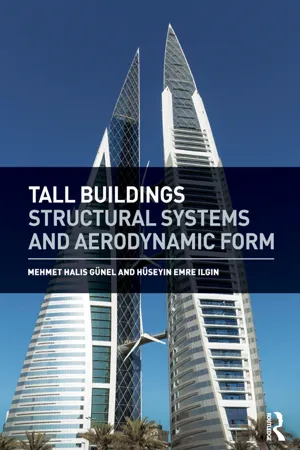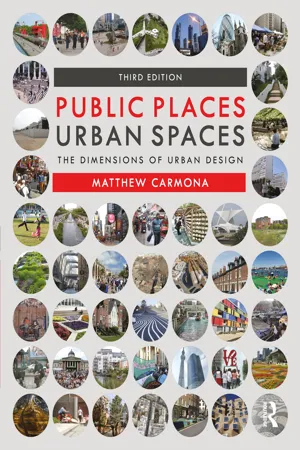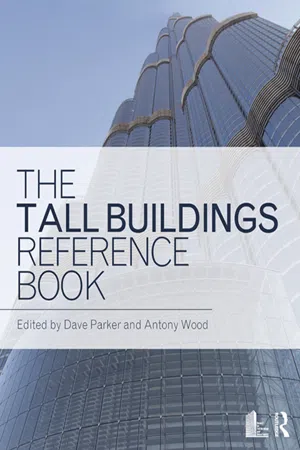Technology & Engineering
Burj Khalifa
The Burj Khalifa is the tallest building in the world, standing at 828 meters in Dubai, United Arab Emirates. It was designed by the architectural firm Skidmore, Owings & Merrill and features cutting-edge engineering and construction techniques. The building's design incorporates elements of Islamic architecture and utilizes advanced technologies to withstand the challenges of its extreme height.
Written by Perlego with AI-assistance
Related key terms
1 of 5
4 Key excerpts on "Burj Khalifa"
- eBook - ePub
Tall Buildings
Structural Systems and Aerodynamic Form
- Mehmet Günel, Hüseyin Ilgin(Authors)
- 2014(Publication Date)
- CRC Press(Publisher)
The 163-storey, 828 m high Burj Khalifa in Dubai (U.A.E) was designed by SOM and Hyder Consulting. It is a reinforced concrete building with an outriggered frame system. The system is also classified as a buttressed core system. The Burj Khalifa gained the title of “the world’s tallest building” in 2010. Moreover, it was the winner of “Global Icon Award 2010” by CTBUH; “Best Tall Building 2010, Middle East and Africa” by CTBUH; and “Distinguished Building Award” in 2011 by AIA (American Institute of Architects).The design of the Burj Khalifa, which derives its main inspiration from the form of a local desert flower, has many traditional Islamic architectural motifs. The cross-section has three axes in the shape of a Y, whose wings end by evoking the shape of a dome. The Y-shaped plan form maximises the exterior view and secures a supported core which is termed “buttressed core”. The building has the appearance of bundled modules that end at different levels so that 21 setbacks are created in a spiral manner below the spire part (structural steel braced frame) of the building. Although it is reminiscent of the bundled-tube form it does not have a tubular structural system. The reduction of the plan area by using setbacks throughout the height of the building, while further highlighting the height of the tower, which appears to be rising towards the sky with acceleration, also reduces wind forces at the upper levels by a reduction in the surface area affected by the wind.According to statements by representatives (William F. Baker, Peter A. Irwin and Ahmad Abdelrazag) of the firms involved in the architectural and structural design of the Burj Khalifa (Skidmore, Owings & Merrill), the wind engineering consultancy (Rowan Williams Davies and Irwin) and the construction (Samsung Engineering and Construction), attention was paid to the effect of wind and aerodynamic form at an early stage in the architectural design and the architectural and structural designs were undertaken in parallel. Thus the Burj Khalifa took shape with the collaborative efforts of architects and engineers in order to reduce the effect of wind as much as possible. The number and location of the modules formed by setbacks throughout the height of the building and the shape of the wings, were determined by wind tunnel tests. The setbacks on the building reduce the effect of wind induced lateral loads by breaking the organisation of the wind flow, namely confusing the wind because reduced plan area especially in a spiral manner causes the wind to encounter reduced and different surface areas throughout the height of the building. - eBook - ePub
- Nick Jones(Author)
- 2015(Publication Date)
- Routledge(Publisher)
36 Although originally written in the 1980s, Klotz’s comments on the appeal and consequences of iconic buildings also suggest how the contemporary action sequences that take place within them might be understood. Capitalising upon the importance of iconic buildings as cultural signs with great value in a global image economy, action sequences also relate these otherwise alienating buildings to bodily experience, appropriating immense structural forms through the body of the action protagonist. The lived world and the immeasurable world are in this way brought together and negotiated.The Burj Khalifa, the tallest building in the world as of 2014, can certainly be understood to have abandoned human proportions. Designed by Adrian Smith, this 2,723-foot-tall multi-purpose structure in the main business district of Dubai is central to the city’s ongoing project to become a hub of tourism through distinctive and occasionally bizarre architectural feats (others include artificial island chains resembling palm trees and a hotel in the shape of an enormous sailboat). The design of the Burj Khalifa references its locality by evoking ‘the geometries of the desert flower and the patterning systems embodied in Islamic architecture’.37 However, its incredible height is in no way a functional necessity but part of a calculated strategy to garner press attention. In this it has been successful, although the amount of occupancy in the building, which contains a ‘15-story hotel, 37 floors of offices, and 1,100 apartments’, was low immediately after opening due to economic problems in Dubai following the financial crisis of 2008 and the collapse of the region’s real-estate market.38 The building thus has a reciprocal relationship with the film that uses it memorably as a setting, Mission: Impossible – Ghost Protocol - eBook - ePub
Public Places Urban Spaces
The Dimensions of Urban Design
- Matthew Carmona(Author)
- 2021(Publication Date)
- Routledge(Publisher)
Dovey (2016: 182) recalls how, following the construction of the Petronas Towers in Kuala Lumpur (1998), the race to construct the world's tallest tower has engaged many cities: Shanghai, Guangzhou, Taipei, Hong Kong and Dubai (4.10). The result has been the production of a fundamentally different building type where the occupation of the building (which becomes less efficient the higher you go) has become secondary to its symbolic capital. 4.10 Burj Khalifa, Dubai The design of the Burj Khalifa is said to reflect Islamic architecture, but the symbolic value of being the world's tallest building was rated even higher, and the height was raised several times during its development to ensure it exceeded the planned height of other (unrealised) towers then in the planning stage. It opened in 2010 just after the 2008 property bubble in Dubai had burst but now forms the centrepiece of an ever-growing new district, all owned by a single developer. Knox (1984: 107) argues that the built environment is not simply an expression of the power exerted at different times by various individuals, social groups and governments, but is also a means by which the prevailing system of power is maintained. This expression of power is often overt and many totalitarian and imperial/colonial regimes, for example, have used the built environment to symbolise political power (Saoud 1995) (see 2.34). As it may not always be desirable to display power, symbolism may “involve ‘modest’ or ‘low profile’ architectural motifs; or carry deliberately misleading messages for the purposes of maintaining social harmony” (Knox 1987: 367). Dovey (1999: 2) observes: “The more that the structures and the presentations of power can be embedded in the framework of everyday life, the less questionable they become and the more effectively they can work.” He suggests that “the exercise of power is slippery and ever-changing. Power naturalises and camouflages itself, chameleon-like within its context - eBook - ePub
- David Parker, Antony Wood, David Parker, Antony Wood(Authors)
- 2013(Publication Date)
- Routledge(Publisher)
Part Four confirm, the structural limits of tall building construction are still out of reach, and the height that any project may aspire to is determined more by the optimism—or ego—of the client than any inadequacies in the strength of materials or ingenuity of the structural engineer. What will motivate the construction of a tower that tops the 828 metres of the Burj Khalifa is unlikely to be a major technological breakthrough; the necessary technology and expertise already exist. Politics and nationalism are likely to be the driving force, backed largely by sovereign wealth funds. Symbolism will be far more relevant than economics.One trend that seems to be emerging as humankind becomes a primarily urban species and cities become ever larger and denser is the development of sites for tall buildings that would have been seen as impractical or too risky even a few years ago. The benign ground conditions and negligible seismicity of Manhattan and Chicago encouraged the development of the modern skyscraper; now supertall buildings are rising on foundations more than 100 metres deep in seismically active locations open to hurricanes or typhoons. As the latter three chapters of Part Four demonstrate, the skills and technology are available to deal realistically with such extreme conditions. Occupant comfort can be maintained even in extreme wind conditions; occupant safety during even major earthquakes is also deliverable.In another quarter of a century these thoughts may generate the same wry amusement as those of Sir Peter Medawar above. It is to be hoped that the actual future will turn out to be far more exciting than anyone can possibly imagine right now.Passage contains an image
Chapter 16 The Limits of Materials and Structures
Richard Tomasetti, Joseph Burns and Dennis Poon DOI: 10.4324/9780203106464-21Introduction
Limitations are best perceived as a function of time. With the accelerating pace of technological change, today’s limits are often yesterday’s science fiction, and probably tomorrow’s routine standards. Nobel laureate Sir Peter Medawar (see the introduction to Part Four
Index pages curate the most relevant extracts from our library of academic textbooks. They’ve been created using an in-house natural language model (NLM), each adding context and meaning to key research topics.



